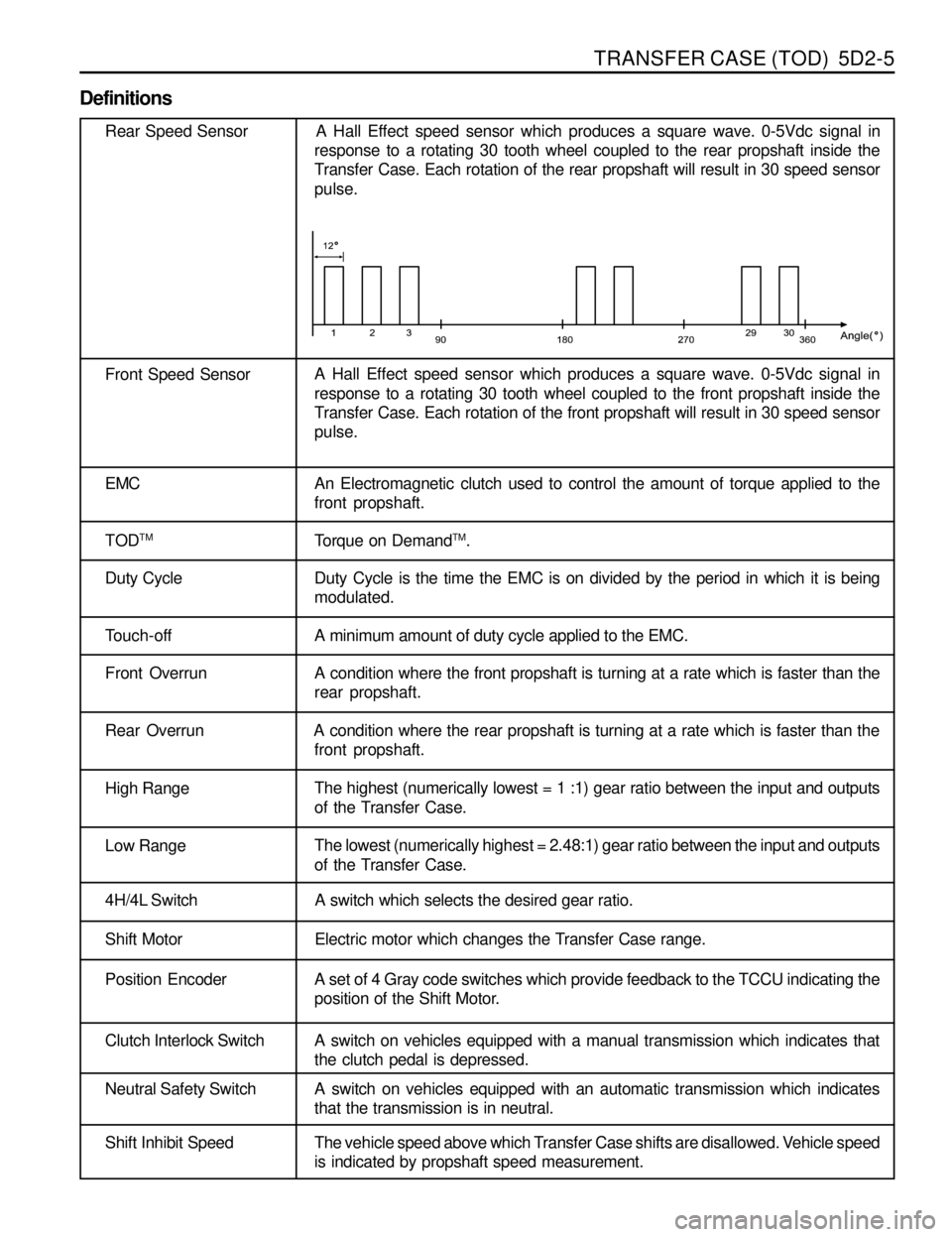1998 SSANGYONG MUSSO wheel
[x] Cancel search: wheelPage 1206 of 1463

5D1-36 TRANSFER CASE (PART TIME 4408)
TRANSFER CASE CONTROL UNIT
(TCCU)
System Description
TCCU is located under the front left handed seat and permits
the vehicle to shift from two-wheel drive to four-wheel drive
(and back shift) according to driver’s switch operation during
driving (For the shifting between 4WD HIGH and 4WD LOW,
stop the vehicle).
1. Shifting from 2H to 4H
lPosition the transfer case switch from '2H' to '4H'.
lShifting is possible during driving.
l'4WD Hl' indicator light will turn on.
2. Shifting from 4H to 2H
lPosition the transfer case switch from '4H' to '2H'.
lShifting is possible during driving.
l'4WD Hl' indicator light will turn off.
3. Shifting between 4H and 4L
lShifting is possible when the vehicle is almost stopped
(below approx. 2 km/h), so it would be better stop the
vehicle.
lIn case of manual transmission equipped vehicle, apply
clutch pedal.
lIn case of auto transmission equipped vehicle, put the
lever position into 'N'.
lPosition the transfer case switch '4H' to '4L' or '4L' to
'4H'.
lAccording to the shifted position, indicator light will turn
on.
Notice
If there are malfunctions during shifting,'4H' or '4L' indicator
light will blink.
Page 1211 of 1463

5D2-4 TRANSFER CASE (TOD)
FUNCTION DESCRIPTION
lTOD System Select Mode (4H and 4L)
4H is the mode when drive normally of which gear ratio is 1:1 and 4L mode distributes power to front and rear
wheels 50:50 of which gear ratio is 2.48:1.
lTOD System Function (select 4H mode)
TOD system controls clutch mechanism to comply with rotation in front and rear propeller shaft and if its difference
exceeds the permissible range, corresponding power is distributed into front wheel through EMC (Electro-Magnetic
Clutch).
Hall effect sensor signals speed on front and rear propeller shafts going through with TOD control unit.
Transfercase clutch coil is activated by variable current on exceeding difference of speed in front and rear propeller
shafts.
lFunction of 4L Mode
When select 4L mode, EMC is locked to apply maximum torque into front and rear propeller shafts. Shift motor
rotates also 4L position by rotation of cam thus propeller shaft torque changes from 1:1 to 2.48:1 by planetary
gear set.
lShift Motor
It locates backside transfer case, which drives rotary helical cam.
When mode select switch changes to 4L, shift fork is on position for 2.48:1 by rotation of helical cam.
lTransfer Case
TOD transfer case distributes power into front and rear axle by operation of 4H/4L switch and shift motor.
Shifting 4H to 4L, is performed towards reducing HI-LO collar by means for connection HI-LO shift fork with
output shaft in order to join with planetary gear. Torque transmits input shaft then sun gear rotating front planetary
gear. Front planetary gear join with output shaft and drives LO position.
Page 1212 of 1463

TRANSFER CASE (TOD) 5D2-5
Definitions
Rear Speed Sensor A Hall Effect speed sensor which produces a square wave. 0-5Vdc signal in
response to a rotating 30 tooth wheel coupled to the rear propshaft inside the
Transfer Case. Each rotation of the rear propshaft will result in 30 speed sensor
pulse.
Front Speed SensorA Hall Effect speed sensor which produces a square wave. 0-5Vdc signal in
response to a rotating 30 tooth wheel coupled to the front propshaft inside the
Transfer Case. Each rotation of the front propshaft will result in 30 speed sensor
pulse.
EMC An Electromagnetic clutch used to control the amount of torque applied to the
front propshaft.
TOD
TMTorque on DemandTM.
Duty Cycle Duty Cycle is the time the EMC is on divided by the period in which it is being
modulated.
Touch-off A minimum amount of duty cycle applied to the EMC.
Front OverrunA condition where the front propshaft is turning at a rate which is faster than the
rear propshaft.
Rear Overrun A condition where the rear propshaft is turning at a rate which is faster than the
front propshaft.
High RangeThe highest (numerically lowest = 1 :1) gear ratio between the input and outputs
of the Transfer Case.
Low RangeThe lowest (numerically highest = 2.48:1) gear ratio between the input and outputs
of the Transfer Case.
4H/4L Switch A switch which selects the desired gear ratio.
Shift Motor Electric motor which changes the Transfer Case range.
Position Encoder A set of 4 Gray code switches which provide feedback to the TCCU indicating the
position of the Shift Motor.
Clutch Interlock Switch A switch on vehicles equipped with a manual transmission which indicates that
the clutch pedal is depressed.
Neutral Safety Switch A switch on vehicles equipped with an automatic transmission which indicates
that the transmission is in neutral.
Shift Inhibit Speed The vehicle speed above which Transfer Case shifts are disallowed. Vehicle speed
is indicated by propshaft speed measurement.
Page 1218 of 1463

TRANSFER CASE (TOD) 5D2-11
4. Electric Shift Default Mode
If the motor fails to reach its destination, the TCCU will attempt the following (in order):
a. The TCCU will wait 3 seconds then attempt the shift again.
b. If the second attempt to reach the destination fails the TCCU will wait 3 seconds then attempt to rotate the
motor back to the original position. If successful, all future shifts will be inhibited until the Ignition is cycled.
c. If the attempt to return to the original position fails, the TCCU will wait 3 seconds then attempt to rotate the
motor to the original position again. If the second attempt to return to the original position is successful, the
“4WD CHECK” lamp will be illuminated, and all future shifts will be inhibited until the Ignition is cycled.
d. If the second attempt to return to the original position fails the motor will be turned off, the “4WD CHECK” lamp
will be illuminated, and all future shifts will be inhibited until the Ignition is cycled.
TODTM System Operation
The TODTM System is responsible for distributing torque between the front and rear axles. The TCCU monitors the
propshaft speeds, operating range (High/Low), and ABS activity and then applies a calculated amount of torque to
the front axle by Pulse Width Modulating the current applied to the EMC.
1. Touch-off Torque
The minimum EMC Duty Cycle is based on the vehicle speed and throttle position
The TCCU receives the TPS signal from the following sources:
On vehicles equipped with CAN, the TCCU receives the TPS signal from the CAN bus.
2. When Slip Detection
The TCCU continuously monitors the front and rear propshaft speeds to detect wheel slip.
3. Wheel Slip Control
When wheel slip is detected the TCCU controls the EMC duty cycle as necessary until the wheel slip is reduced
below the allowable limit. The EMC Duty Cycle will then be reduced to the Touch-Off value.
4. Brake/ABS Strategy
When the ABS System is active, the EMC Duty Cycle is set to a fixed duty cycle (30%) to aid in braking without
counteracting the ABS System.
5. 4L Strategy
When the system is operating in 4L, the TCCU continues TOD
TM (operation provided that the propshaft speed is
below 175 rpm (5220 pulses/minute)). When the speed increases above 175 rpm, the EMC Duty Cycle is set to
the maximum value (88%) which applies the maximum available torque to the front axle.
Page 1223 of 1463

5D2-16 TRANSFER CASE (TOD)
g. If the shift motor/position encoder assembly failure (other than a motor failure which occurs when the motor is
energized) recovers continuously for one second the TCCU will function normally. The “4WD CHECK” lamp is
turned off but the fault code will remain in memory.
h. A motor failure (i.e. open or short circuit) which occurs when the motor is energized can only be cleared by
cycling the ignition off-on.
3. Front Speed Sensor Test
If a Front Speed Sensor fault is detected continuously for 0.5 second the “4WD CHECK” lamp is illuminated. The
TCCU then responds as follows:
a. If the system is in High Range the TCCU uses the Rear Speed Sensor to determine the EMC Touch Off level
and wheel slip control is suspended.
b. If the system is in Low Range, the EMC Duty Cycle is set to maximum (independent of vehicle speed) until the
system is shifted out of 4L.
c. All Electric Shift activity is halted until the Ignition is cycled. If a shift is in progress it will be completed.
If the Front Speed Sensor recovers continuously for O.5 second the TCCU will function normally. The “4WD
CHECK” lamp is turned off but the fault code will remain in memory.
4. Rear Speed Sensor Test
If a Rear Speed Sensor fault is detected continuously for 0.5 second the “4WD CHECK” lamp is illuminated. The
TCCU then responds as follows:
a. If the system is in High Range the TCCU uses the Front Speed Sensor to determine the EMC Touch Off level
and wheel slip control is suspended.
b. If the system is in Low Range, the EMC Duty Cycle is set to maximum (independent of vehicle speed) until the
system is shifted out of 4L.
c. All Electric Shift activity is halted until the Ignition is cycled. If a shift is in progress it will be completed.
If the Rear Speed Sensor recovers continuously for 0.5 second the TCCU will function normally. The “4WD
CHECK” lamp is turned off but the fault code will remain in memory.
5. Both Speed Sensor Faulty
If both the Front and Rear Speed Sensors are faulty continuously for 0.5 seconds the “4WD CHECK” lamp is
illuminated. The TCCU then responds as follows:
a. If the system is in High Range the TCCU sets the EMC Touch Off level based on a vehicle speed of 0 and wheel
slip control is suspended.
b. If the system is in Low Range, the EMC Duty Cycle is set to maximum until the system is shifted out of 4L.
c. All Electric Shift activity is halted until the Ignition is cycled. If a shift is in progress it will be completed.
If both Speed Sensors recover continuously for 0.5 second the TCCU will function normally. The “4WD CHECK”
lamp is turned off but the fault code will remain in memory.
6. EMC Test
The EMC is tested for open circuit or short circuit to ground. If a fault is detected continuously for 0.8 second the
“4WD CHECK” lamp is turned on and all TODTM activity is halted.
If the EMC recovers continuously for 0.8 second the TCCU will function normally. The “4WD CHECK” lamp is
turned off but the fault code will remain in memory.
Page 1249 of 1463

5D2-42 TRANSFER CASE (TOD)
1 Bearing
2 Bushing
3 Carrier Assembly
4 Sun Gear
5 Thrust Plate
6 Input Shaft
7 Output Shaft Thrust Washer
8 Bearing
9 Retaining Ring
10 Snap Ring
11 High-low Collar
12 Rear Output Shaft
13 Oil Strainer
14 Coupling Hose
15 Hose Clamp
16 Pump Assembly
17 Thrust Washer
18 Sprocket, Drive (24T)
19 Clutch Pack Assembly
20 Insulator Washer
21 Armature
22 Snap Ring
23 Wave Washer
24 Apply Cam
2 5 Ball
26 Cam and Coil Assembly
27 Nut, Metric
28 Output Shaft Yoke Washer
29 Oil Seal
30 Case Flange
3 1 Bolt
32 Upper Speed Sensor (Rear)
3 3 Nut
34 Washer
3 7 Bolt
38 Tag, Identification
39 Thrust Bearing
40 Clutch Coil Assembly
41 Fork, Reduction Shift42 Shift Rail
43 Shaft, Shift
44 Spacer
45 Torsion Spring
46 Shift Cam
47 Transfer Case Shift Motor
4 8 Bolt
4 9 J-clip
50 Connector Retainer
5 1 Bolt
52 Support Stud
53 Lower Speed Sensor (Front)
5 4 Plug
55 Identification Decal
56 Cover
57 Tone Wheel, Lower
58 Chain, Drive
59 Sprocket, Driven (24T)
61 Magnet
62 Case
63 Case Flange and Output Shaft
64 Barb, Breather
68 Spiral Pin
69 Oil Seal
70 Pin, Dowel
71 Ring Gear
72 Retaining Ring
73 Snap Ring
74 Bearing
75 Snap Ring
76 Bearing
77 Speedometer Drive Gear
78 Facing, Shift Fork
79 Upper Tone Wheel
80 Oil Seal
81 Bearing Sleeve
82 Bearing
Page 1251 of 1463

5D2-44 TRANSFER CASE (TOD)
9. Remove the bolts that retain the front case to the
rear case. Make sure that the front case is facing
downward so that the rear cover is facing upwards.
Pry on the bosses and separate the front case from
the rear case. Remove all traces of gasket sealant
from the mating surfaces of the front case and rear
case.
10. If the speedometer drive gear is to be replaced, first
remove the flange seal by prying and pulling the
curved-up lip of the flange seal. Do not damage the
bearing, bearing cage or case. Remove and discard
the flange seal. Remove the speedometer drive gear
and upper tone wheel.
69 Yoke to Flange Seal
75 Snap Ring
76 Bearing
77 Speedometer Drive Gear
79 Upper Tone Wheel
40 Clutch Coil
40a Clutch Coil Retaining Bolts
40b Wire
11. If the rear output shaft bearing requires replacing, remove
the internal snap ring that retains the bearing in the bore.
From the outside of the case, drive out the bearing.
12. Remove the three nuts and washers retaining the clutch
coil assembly to the rear case. Pull the assembly, along
with the O-ring and wire, from the case.
13. Remove bearing assembly from output shaft.
Remove the clutch housing from the output shaft.
Remove the balls and apply cam and wave washer from
the output shaft.
Remove snap ring from output shaft. Remove clutch pack
assembly from output shaft.
25 Ball
26 Cam and Coil Assembly
Page 1256 of 1463

TRANSFER CASE (TOD) 5D2-49
12. Install the output shaft and oil pump in the input shaft.
Make sure that the internal splines of the ouput shaft
engage the internal splines of the high-low shift collar. Make
sure that the oil pump retainer arm and oil filter leg are in
the groove and slot of the front case.
13. Install the magnet in the slot in the front case just above
the oil filter leg.
14. Install the front output shaft in the front case.
15. Install the thrust washer on the rear output shaft. Install
the chain, drive sprocket and driven sprocket as an
assembly over the output shaft.
Notice
lThe driven sprocket (on the front output shaft) must
be installed with the marking REAR facing toward the
rear case, if so marked.
lDrive sprocket has a bushing pressed into it.
16. Install tone wheel onto the front output shaft. Make sure
the spline on the tone wheel engages the spline on the
front output shaft.
17. Install clutch pack assembly onto the rear output shaft.
Make sure the spline of the clutch pack engages to the
spline of the sprocket.
18. Install snap ring onto the rear output shaft. Start the snap
ring over the spline and use the wave spring to seat the
snap ring in the snap ring groove. If the snap ring will not
install, the thrust washer inside the clutch pack may not
be seated properly.
1 2 Rear Output Shaft
1 6 Oil Pump6 1 Magnet 1 2 Rear Output Shaft
1 3 Oil Strainer
1 6 Oil Pump
16a Pump Retainer